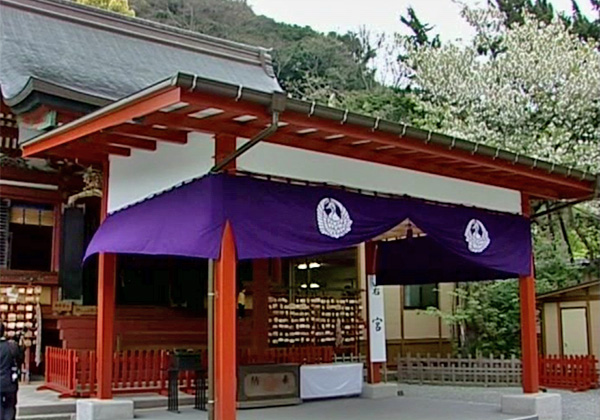Tsurugaoka Hachimangu Shrine
| Official Name | Tsurugaoka Hachimangu Shrine {Pronounced tsu-roo-gah-oh-kah hah-chee-man-goo} |
|---|---|
| Religious sect | Shinto |
| Founded | in 1180 by Yoritomo Minamoto {yoh-re-toh-moh me-nah-moh-toh} |
| Address | 1-31, Yukinoshita 2-chome, Kamakura, Kanagawa 248-0005 (show route from current location ) |
| Location | 800 meters north-northeast of Kamakura Station |
| Time needed to get there | 15 minutes |
| Admission | Free |
| Phone number | 0467-22-0315 |
| Restrooms | Available |
Historical Overview
Yoritomo Minamoto (1147-1199), the founder of the Kamakura Shogunate and the first Shogun in the Kamakura Period (1185-1333), overwhelmingly defeated the rival clan of Taira in 1180 to become the military ruler of Japan and set up his headquarters in Kamakura making it de facto capital of the nation. The first thing he did after his triumph was to build a grand shrine of Hachiman, the tutelary deity of the Minamoto clan, and revere it as the God of War, to demonstrate his supremacy as a new dictator. There was, and still exists a small shrine established by his ancestor near the Kamakura beach. As a replacement of this old shrine, he constructed a new one at the present site in 1180. Unfortunately, however, it was destroyed by fire in 1191. He immediately began reconstruction of the new shrine, which is the origin of the present-day Tsurugaoka Hachimangu Shrine.
Before the Meiji Imperial Restoration in 1868, the Shrine was a large complex of religious structures that mixed elements of Shinto and Buddhism under the concept that Shinto deities were manifestation of Buddhism divinities. Most important was the identification of the Sun Goddess Amaterasu with Buddha Mahavairocana, harmonizing the teachings of both religions. In other words, it was syncretized mixture of Shinto and Buddhism, Shingon sect in particular, and therefore, the Shrine had been called Tsurugaoka Hachimangu Shrine Temple. In its golden days, the Shrine had as many as 33 structures including those for Buddhists. If anything, Buddhists had more power than Shintoists as the Shrine was mostly managed by Buddhist priests.
The new government after the Meiji Restoration, however, purged Shinto of Buddhist elements or ordered to segregate Buddhism from Shinto, making the latter as the state religion. As a result, many of the valuable structures, statues and the likes in here associated with Buddhism were burned down, destroyed, sold cheap overseas or thrown away. Some were fortunately moved to other Buddhist temples. The Deva King Gate, for example, was relocated to Jufukuji. From the Restoration up until the end of the Second World War, the Shrine had been run by the national government. After the War, it became an independent religious institution. With its historic background, the Shrine is one of the three largest Hachimangu in Japan following Usa {woo-sah} Hachimangu in Oita Prefecture and Iwa Shimizu {e-wah she-me-zoo} Hachimangu in Kyoto, drawing roughly 10 million visitors every year. On New Year Days, two million people visit here for just three days. Kamakura Station and the road leading to the Shrine are flooded with them and it may take a full hour to get there, which otherwise takes only ten to fifteen minutes.
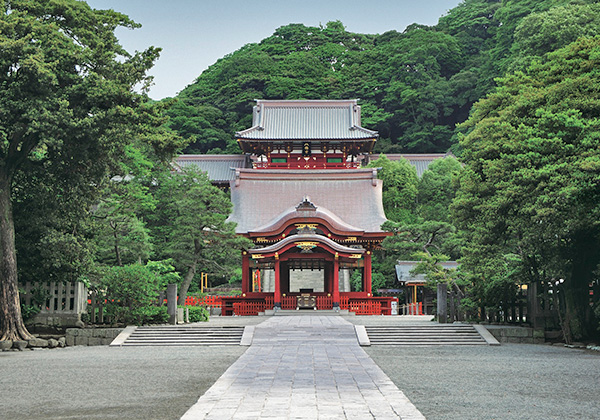
Dankazura {dan-kah-zoo-rah} or the approach to the Shrine

Turn left at the traffic light straight ahead of the east exit of Kamakura Station, and you will find a big torii Gate, about six-meter high with a pair of stone-carved dogs standing near the gate. Torii-gates as well as a pair of dogs are the symbols for Shinto shrines and the easiest way to tell Shinto shrines from Buddhist temples. There are three torii gates for this particular Shrine and this one is the second. The first one is located south, near the beach and the last (third) one to the north in front of the Shrine. From the second torii to the Shrine, there is an elevated walkpath called Dankazura in Japanese, roughly 50 centimeters high, 3 meters wide and 460 meters long, lined with some 310 cherry trees and azaleas on both sides. In early April, the path turns long arch made of cherry blossoms. Cherry seedlings were planted in 1918. Its botanical name is Prunus Yedoenis, same as those near the Potomac River in Washington D.C., which were the gift to the American First Lady Mrs. Taft presented by the Municipal Government of Tokyo in 1912. This walkpath was originally constructed at the command of Yoritomo when his wife Masako {mah-sah-koh} (1157-1225) was pregnant. At the age of 36, Yoritomo had two daughters but no heir apparent yet. Under the Kamakura Shogunate system, only the eldest male child was qualified to succeed to the Shogun's position. (The same holds true for today's imperial family). The couple really wanted to have a baby boy, and they prayed to their Hachiman deity wishing that the next child be a boy, dedicating this path to the Shrine in 1182. It was modeled after Miyako Oji {me-yah-koh-o-gee}, the main boulevard of Capital Kyoto. Their prayer was answered the same year. The new born child was male and named Yoriie {yoh-re-e-a}, who later assumed the seat of the Second Shogun. The broad way with Dankazura in the center was thus called Wakamiya-oji or Young Prince Avenue. A recent excavation revealed that the original road was quite different from what we see today. It was as wide as 33 meters, and on both sides, there were moats, 3 meters wide and 1.5 meters deep to keep enemy from coming in. The walkpath had been stretching from the first torii gate near the beach up to the third one for 1,500 meters, but the path between the first gate and the second one was flattened in 1878 to cope with ever-increasing traffic.
A pair of ponds
Beyond the third torii, you are already in the Shrine grounds. Go over a bridge (there are three small bridges. One in the middle is arched and called "drum bridge") and you will find a pond both sides. They were made by Masako, and are called "Genpei" {ghen-pay} pond. "Gen" stands for Minamoto and "Pei" Taira, meaning the right-hand pond (obviously larger than the other) is for the Minamotos and the left-hand one for the Tairas. In summer when the immense expanses of lotusleaves cover all over the pond, the right-hand pond has white (Minamoto clan's symbol color meaning purity) flowers, whereas left-side pond blood-red ones (Taira clan's symbol color). But, today, each pond has both red and white flowers. In winter, however, the scene completely changes with lotus leaves and flowers nowhere in sight as shown in the photos. Also, the Minamoto pond is dotted with three islets, and Taira pond with four. "Three" is pronounced "san" in Japanese which also means birth or creating something, while "four" is called "shi", homonym for "death". Masako wished creativity for the Minamotos and death for the Tairas. These ponds are good evidence to remind us of the two-warlord clans who waged fierce battles more than 800 years ago.
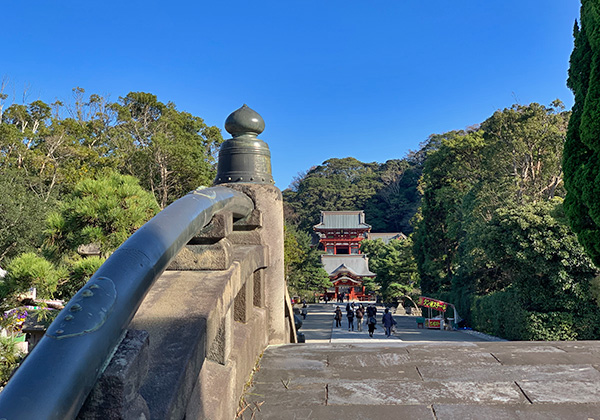
Yabusame {yah-boo-sah-meh} or Mounted-archery Lane

Back to the main approach, you will see two roofs about 200 meters straight ahead, both copper rusted. The nearer one is the Ritual Dance Stage and the Main Hall appears in the rear. Halfway through the approach, there is a dirt path crossing, about 6 meters wide spanning 300 meters between the west and east torii. Twice every year, one on third Sunday of April during the Kamakura Spring Festival, and the other on September 16 during the Shrine's annual festival, a show of Yabusame or mounted archery takes place right on this path. Man on a galloping horse clad with an ancient hunting suit shoots arrows at the fixed targets in quick succession. In the era of Yoritomo, cavalry battle was the most common method of warfare and the Minamoto clan was among the most skillful. How accurately they can hit the mark was an important yardstick to measure the martial skills and powers of samurai. It was a great honor for a samurai to participate this event and winners were well rewarded. Yoritomo initiated this competition in 1187 and made it a regular practice to help samurai enhance their skills of shooting. The Yabusame archery today is performed for the commemoration of samurai warriors of the Kamakura era. As it is one of the major events the Shrine holds, many spectators line up both side of the lane to watch the competition. TheYabusame lane was also the starting point of Kamakura High Roads, which spread north, northeast and east connecting Kamakura to other major regions including Kyoto. Also popular those days were dog-hunting games. If present-day pet-lovers ever watched this game, they might have fallen into a swoon because of its brutality. Twelve samurai on horseback compete shooting at ten released dogs in an enclosure and the game complete with 15 rounds. One hundred and fifty dogs were slaughtered in one competition. Due to its cruelty, there is no such games today.
Maiden {my-den} or Ritual Dance Stage
Walk straight ahead for about 200 meters or so and there is a red-colored, square, roofed 1.5-meter-high stage in the center of the courtyard. This is the Ritual Dance Stage to commemorate Lady Shizuka {she-zoo-kah} (birth and death years unknown), a sweetheart of Yoshitsune Minamoto {yo-she-tsu-neh me-nah-moh-toh} (1159-1189), Yoritomo's half-brother. She had unwillingly to perform the historic dance in the Shrine in 1186 to entertain Yoritomo as well as his family. Back at the time, Yoshitsune's behavior angered Yoritomo to the point that Yoritomo ordered his men to kill Yoshitsune. While Yoshitsune was on the run, Lady Shizuka was unfortunately caught and brought to Kamakura. She had grown up in Kyoto, beautiful and elegant with lots of refined Kyoto culture. She was also known as an excellent dancer. Yoritomo tried repeatedly to make her dance but she always turned down. Persuaded by Masako, she finally and reluctantly accepted to dance in front of Yoritomo. While dancing, she sang a song which expressed her deep feeling of love toward estranged and fugitive Yoshitsune, which infuriated Yoritomo badly. Yoritomo had expected that she would dance and sing to praise his heroism. At the time, Lady Shizuka was pregnant with Yoshitsune's child. After the dancing, Yoritomo ordered to kill Lady Shizuka's baby if the baby turned out to be a boy. Lady Shizuka prayed that her baby be a girl, but gods did not side with her. The baby was a boy. He was immediately killed and thrown away at the beach of Kamakura. Today, dedicatory dances and music are performed on the second Sunday of April every year during the Kamakura Festival.
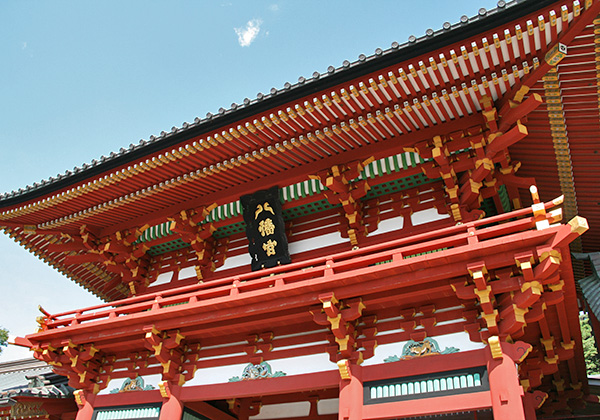
A ginkgo tree
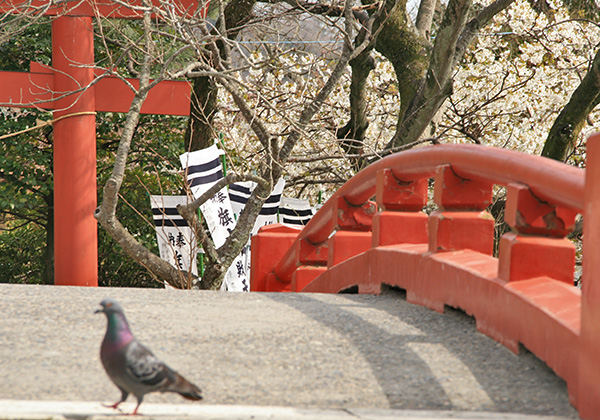
Beyond the Ritual Dance Stage, there is a flight of 61-stone-steps. At the left-hand side of the flight, there was a huge gingko tree. The nearby signpost reads that the tree is more than 1000 years old and 30.5 meters high. Its root-diameter measures about 1.5 meters.
(On March 10, 2010, a spring storm brought down the ginkgo tree.)
This is exactly the place where Sanetomo {sah-neh-toh-moh} Minamoto (1192-1219), the Third Shogun, was stabbed to death in 1219 by his nephew Kugyo {koo-gyo} Minamoto (1200-1219), then the chief of the Shrine, who hid behind the tree and attacked Sanetomo with a sword when Sanetomo was about to enter the Main Hall to attend a ceremony for his receiving one of the highest official titles conferred by the Imperial Court in Kyoto. Why on earth did Kugyo assassinate his uncle? Historians analyze this way. Sanetomo paid too much attention to Kyoto culture and played up to the Imperial Court, which had authorization to grant official court titles. As a result, Sanetomo was promoted too quickly and his promotion made Kugyo jealous. Secondly, Kugyo thought that had not there been for Sanetomo, Kugyo himself would have succeeded to the Shogunate chair as the first son of Yoriie. Another jealousy. However, the exact cause of the assassination is not necessarily clear. Some says it was an conspiracy plotted by Hojo clans. Right after the assassination, Kugyo himself was also killed by Sanetomo's guards.
Main Hall
The building is made of two parts: Haiden or the oratory hall in front, and Honden or the inner sanctum, which is the most sacred part of the entire Shrine. Haiden is the place where all kinds of ritual ceremonies and worships are performed. Hachimangu Shrine is dedicated to Emperor Ojin {oh-gin} (?-310),the Fifteenth Emperor in the early 4th century (current emperor is said to be 125th) together with Empress Jingu (different Chinese ideograph from the one meaning a shrine), and is widely worshiped as the god of warriors. The Minamoto clan was descendants of imperial family. To be more specific, they were the descendants of the 56th Emperor Seiwa (850-880), and Hachimangu was Emperor Seiwa's tutelary deity. Thus, Yoritomo as a descendant of Emperor Seiwa became an pious adherent of Hachimangu. Originally, the Shrine had been built by Yoriyoshi {yo-re-yo-she} Minamoto (985-1078), Yoritomo's great-great-grandfather, near the beach of Kamakura in 1063 and it still exists as Yui Wakamiya {you-e wah-kah-me-yah} Shrine as noted earlier, but it was too small to show off Minamoto clan's muscles. Yoritomo built a new Hachimangu shrine here and named it Tsurugaoka Hachimangu. The vermillion main sanctuary was rebuilt in 1828 by Ienari Tokugawa {e-eh-nah-re toh-koo-gah-wah} (1773-1841), the 11th Tokugawa Shogun. (The Tokugawa family claimed they were offspring descended from the Minamotos, and protected the Shrine). Vermillion color dominates the whole wooden structures making a beautiful contrast with verdure of the surrounding trees. Glittering decorations and carvings are spectacular. The style of architecture is called Gongen Zukuri {gon-ghen zoo-koo-re}, or consisting of two structures, or two gable-roofs in tiers, the oratory in front and the sanctum at the rear, which convey an extraordinary sense of majesty and power. The sanctum does not contains any statues like those of temples but is adorned with symbolical objects of worship such as a mirror made of polished metal, a sword (both are regalias of the imperial family), a tablet, zig-zag cuts of white paper called Gohei {go-hay} being placed on the altar.
There is a traditional manner to pray before the Haiden of Shinto shrines: Bow twice, clap hands twice and bow once again. Money offering is also needed before the pray. The rich throw a 10,000-yen bill or two, but most people toss in a 10-yen coin into the offertory box. I don't think any gods ever discriminates worshipers depending upon the amount of money they offer. Inside the oratory, some people may be sitting on the tatami-mat floor. They are here to ask Shinto priests to pray to the Shrine god for their well-being such as family safety, business prosperity, recovery from illness, etc. A busy season for the Shinto priests is early to mid-November, when family having children whose ages reach seven, five and three usually visit the Shrine clad with beautiful kimono or dress coupled with their parents and have the priest pray for their good health. The ceremony is called Shichi-go-san {she-che-g-san} or ritual at the age of seven, five and three.
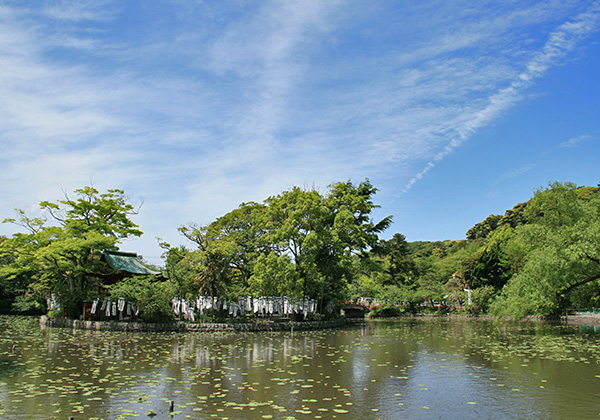
Treasure House
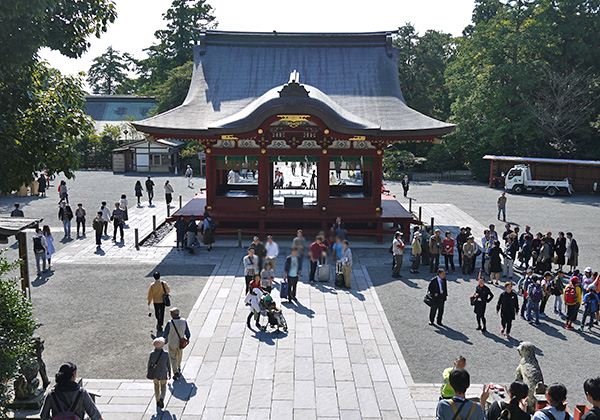
On the left-hand side of the Main Hall, there is an entrance to the corridor-type Treasure House where the Shrine's valuable objects are exhibited. Included among them are: Seven portable-shrines made in 17th to 18th century, ancient swords, two Yoritomo's sedentary statues, a folding screen on which various stages of war between the Minamoto and Taira clans are painted, a twelve-layered robe for court ladies, a suit of armor, ancient brush-writings and various wooden masks. A notable art work is a lacquered inkstone case decorated with laminae of mother-of-pearl depicting chrysanthemum flowers with flying birds. The case was a gift conferred on Yoritomo by Emperor Goshirakawa {go-she-rah-kah-wah} (1127-1192). Gold lacquered quivers of mother-of-pearl work and black-lacquered arrows are also renowned. In New Year Days, the Shrine sells Hamaya {hah-mah-yah} or exorcising arrows as good-luck amulets, which originate in this black arrows. All lacquered artifacts are National Treasures and are now stored at the Kamakura Museum. Admission for this House is 200-yen. Open from 9:00 to 16:00.
